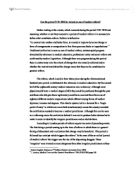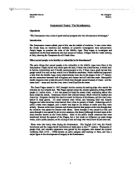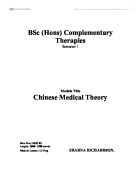The foundation of medical associations during the period 1750-1850 led to a birth of professional unity. This was set in motion with the foundation of provincial medical clubs and societies which began to appear in the late eighteenth century. One of the first objectives of reform was to decrease the division between the university trained and apprentishiped practitioners. Narrowing the gap would meet the medical needs of a whole population and achieve professional unity.2 The breakdown of traditional divisions is evidence of actual reform taking place in this period. Wear believes that the most important feature of medical practise in the period of medical reform was the extent to which there was a large degree of overlap in everyday clinical practise. The established tripartite divisions were beginning to merge. One of the members of the Royal College of Physicians at this time said:
‘ physicians, surgeons and apothecary are the ancient, the true, the English arrangement…This adapted, this scientific, this ancient division of labour the medical reformer seeks to destroy.’
The Royal College of Physicians was seen as composed of gentlemen who avoided manual work and were viewed as snobbish were been increasingly criticised by the late eighteenth early nineteenth century. This coincided with the growth of the academic status and influence of surgeons who down dominated hospitals and were able to command higher fees.
It was stated in an editorial of the British and Foreign Medical Review 1840 that:
‘no reform can have a chance of permanency unless, it adapts itself to those wants of the public which have been so unequivocally demonstrated; namely, by supplying an adequately qualified class of general practitioner’
The general practitioners were not a liked group in medical society and any surgeon who practised midwifery or pharmacy was excluded from privilege within the Royal College of Surgeons. Both the Royal College of Surgeons and Physicians were deeply suspicious of general practitioners as they feared that they would take over the majority of medical practise. As the popularity of a career in general practise grew, reflected in the figures of those who received their LSA reaching 400-500 per year between 1815-1850, medicine as a profession became overcrowded. Despite crippling competition the one thing with general practitioners yearned for more than anything was professional respectability and an institution to represent their views1. Again reform was set in motion. The creation of the National Association of General Practitioners in 1845 was established in the hope that it, and other associations like it which were also been established, would lead to the creation of a College of General Practitioners. An agreement that this college should be established as signed, after five years of setbacks, by all heads of the medical corporations was rejected at the last minute by the Royal College of Surgeons. At the same time they ended any petitions by general practitioners for some years. This is another example of failed reform due to the attitude of the Royal Colleges.
Despite blocking of reforms by the Royal College they could not prevent the rise of the general practitioner. The mid nineteenth century is often termed as giving rise to the cult of the family doctor.1 It was at this time that medical practitioners became a family figure and a prominent man in a town or village. General Practitioners looked towards the model of the family doctor which was to become the backbone of British medicine.
In the eighteenth century the medical profession sought hospital reform, in particular the medicalisation of the hospital.2 At the beginning of the century hospitals took many forms and served many functions. The French hôpital général, an institution similar to the English poorhouse, sheltered beggars, orphans, vagabonds, prostitutes and thieves alongside the sick and the mad. However by 1800 all sizable English towns had a hospital. Alongside these public lunatic asylums were founded in Liverpool, Manchester and York by 1800. A further new institution was the lying in hospital. The first of these maternity hospitals, the British appeared in 1749 and was followed by three more by 1765. Hospitals provided treatment, food, bed-rest and convalesence and by 1800 London’s hospitals alone were handling over 20, 000 patients a year.
The beginning of this so-called period of medical reform also witnessed the rise of clinical medicine and disease theory. Previously patients had been diagnosed based of voluntary patient testimony and the traditional diagnostic uses of the ‘five senses’: they would feel the pulse, sniff for indications of decay, taste the urine, listen for breathing irregularities and observe skin colour.3 By the 1750s new bedside skills were emerging. The technique of percussion of the chest, for example, was adopted as a way of detecting pulmonary disease in 1808. Medical education also began to place greater influence upon clinical skills. From 1750 the Edinburgh medical school set up a special clinical ward with the patients serving as teaching material for clinical lectures. Students were now also expected to visit patients bedsides for themselves.
In the eighteenth century the patients desire to be cured of his symptoms rather than diagnosed of his disease had lead to symptoms been regarded as the disease itself rather than secondary signs of internal problems.1 By the nineteenth century developments in medical knowledge meant that scientific knowledge based on relating symptoms to changes in vital organs became available. This development and knowledge was taken from France and in particular the Paris hospitals where extensive post mortems and clinical examinations were taking place. Scientific knowledge also initiated a change to the aims of medical treatment from the alleviations of suffering towards a cure.
In the case of this question it is necessary to look at each aspect of supposed reform and then ask if it constitutes a reform. Only in this way can we begin to evaluate whether or not the period 1750-1850 can be called a period of medical reform.
It cannot be denied that medical education was greatly improved over the hundred-year period. Loudon believes that:
‘A new and enlightened profession initiated a system of medical education and
care based on scientific principles which ushered in medicine as we know it today.’
It is true that much of what was established at this time has remained in place but in defining reform one of the specifications is, ‘to convert into a new and better form’. In the case of medical education and it still been similar today, it is in the continuity of some of the less desirable elements. For example the failure of a ‘single portal of entry’ means that to this day British doctors have a variety of ‘registerable qualifications’.2 The idea of reform is also a difficult one to define. Although the dictionary definition of reform may be met by a change does this mean that it constitutes genuine reform? This question is particularly relevant when looking at education. The call for a ‘single portal of entry’ was more for ease of defining the regular from the irregular than it was about producing better doctors. Therefore many of the so called reforms must not be read as ‘progress’ but as realignments to meet new needs
In the case of the problem of irregulars, in particular the druggists medical reform was blocked by the Royal Colleges. Although reform was not actually achieved when it comes to the outlaw of irregular practise this was never a practical possibility. However with Dr Harrison’s proposals what occurred was attempted reform. Despite the fact that it did not work the spirit of reform can be seen and perhaps that is what is more central to the period.
The hospital and other new instruments of healing which were appearing in the late eighteenth early nineteenth century are evidence of real medical reform. In accordance with the definition they were converted into a new and better form.
The question posed by Loudon: ‘Is medical legislation a sign of advance’ is one which needs to be answered when looking at the Medical Act. The Medical Act 1858 established a unified medical register of all approved practitioners, specified entry qualifications and created a General Medical Council (GMC) to be both an ethical and legal watchdog with the power to bring those responsible for malpractice to call. Despite this act appearing to represent reform it mirrored the 1815 Apothecaries Act as critics disowned it as a reform as it essentially confirmed the status quo. The GMC was dominated by the colleges, unlicensed practise continued to be lawful and physicians and surgeons continued to strengthen their positions. Although the act changed things it did not free it from previous faults or imperfection and therefore is not a document of reform.
My personal view is that, as is the belief of Loudon the medical reform actually began later than 1750, Wear proposes 1794, and ended later than 1850 with the Medical Act Amendment Act 1886. I also believe that although there was reform in some areas such as education and regulation, the period was more about laying the foundations for future advances than it was reform. The period cannot be seen as pure reform as although there was a determination to improve standards of medical education and care it was inextricably linked with personal ambition and aspirations towards professional, social and financial success and respectability.1
Despite the continuing debate as to whether or not the events of this period constitute reform what is certain is that the period marked, what Wear calls, ‘a watershed between a low plateau in the eighteenth century and the beginning of modern medicine.’
Bibliography
Secondary sources
Books
I. Loudon, Medical Care and the General Practitioner 1750-1850 (Oxford University Press 1986)
A. Wear, Medicine in Society (Cambridge University Press 1998)
I. Lawrence et al, The Western Medical Tradition 800 BC to AD 1800 (Cambridge University Press 1995)
R. Woods, Urban Disease and Mortality in Nineteenth Century England (St Martins
Press 1984)
R. Porter, The Greatest Benefit to Mankind:A Medical History of Humanity from Antiquity to Present. (Fontana Press 1999)
N Poynter, Medicine and Man (Penguin Books 1971)
1 Oxford English Dictionary 2nd Edition (Oxford University Press 1989)
2 I. Loudon, Medical Care and the General Practitioner 1750-1850 (1986) page 160
1 I. Loudon, Medical Care and the General Practitioner 1750-1850 (1986) page 152
2 A. Wear, Medicine in Society (1998) page 233
1 A. Wear, Medicine in Society (1998) page 241
1A. Wear, Medicine in Society (1998) page 240
2 I. Lawrence et al, The Western Medical Tradition 800 BC to AD 1800 (1995) page 468
1 R. Woods, Urban Disease and Mortality in Nineteenth Century England (1984) page 69
2 A. Wear, Medicine in Society (1998) page 222
1 A. Wear, Medicine in Society (1998) page 246







